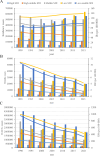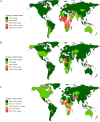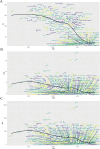Global, regional, and national burden of childhood cardiovascular disease: trends from 1990 to 2021
- PMID: 39722769
- PMCID: PMC11668807
- DOI: 10.3389/fped.2024.1495238
Global, regional, and national burden of childhood cardiovascular disease: trends from 1990 to 2021
Abstract
Background: Childhood cardiovascular disease (CVD) is an emerging public health concern, with rising incidence linked to obesity and diabetes. Despite advancements in care, significant disparities persist across regions and socioeconomic groups. This study analyzed the global, regional, and national burden of childhood CVD from 1990 to 2021.
Methods: A cross-sectional study utilizing data from the Global Burden of Disease (GBD) 2021 was conducted. We analyzed children aged 0-14 years, categorizing them into age groups and assessing trends in incidence, mortality, and disability-adjusted life years (DALYs) across 204 countries. Statistical analyses included linear regression to calculate estimated annual percentage changes and assess temporal trends.
Results: The study revealed a 25% global increase in childhood CVD incidence over three decades, with significant disparities observed across different socioeconomic regions. Mortality and DALYs associated with CVD had decreased globally by 59% and 55% respectively, reflecting advances in medical technology and healthcare access. However, these improvements were not uniformly distributed, with low socio-demographic index regions exhibiting both the highest incidences and slowest declines in CVD-related health burdens. Environmental risks, such as extreme temperatures, also contributed to CVD mortality.
Conclusions: While mortality and DALYs due to childhood CVD have declined globally, rising incidence and persistent disparities highlight the need for targeted interventions. Addressing socio-economic factors and enhancing access to quality care are crucial for reducing the global burden of childhood CVD.
Keywords: cardiovascular disease; childhood; death; metabolic disease; prevalance.
© 2024 Wang, Yi and Chen.
Conflict of interest statement
The authors declare that the research was conducted in the absence of any commercial or financial relationships that could be construed as a potential conflict of interest.
Figures





Similar articles
-
Burden of disease scenarios for 204 countries and territories, 2022-2050: a forecasting analysis for the Global Burden of Disease Study 2021.Lancet. 2024 May 18;403(10440):2204-2256. doi: 10.1016/S0140-6736(24)00685-8. Lancet. 2024. PMID: 38762325 Free PMC article.
-
Global, Regional, and National Death, and Disability-Adjusted Life-Years (DALYs) for Cardiovascular Disease in 2017 and Trends and Risk Analysis From 1990 to 2017 Using the Global Burden of Disease Study and Implications for Prevention.Front Public Health. 2021 Oct 29;9:559751. doi: 10.3389/fpubh.2021.559751. eCollection 2021. Front Public Health. 2021. PMID: 34778156 Free PMC article.
-
Global, regional, and national burden of esophageal cancer: a systematic analysis of the Global Burden of Disease Study 2021.Biomark Res. 2025 Jan 6;13(1):3. doi: 10.1186/s40364-024-00718-2. Biomark Res. 2025. PMID: 39762900 Free PMC article.
-
Global trends and regional differences in mortality of cardiovascular disease and its impact on longevity, 1980-2021: Age-period-cohort analyses and life expectancy decomposition based on the Global Burden of Disease study 2021.Ageing Res Rev. 2025 Jan;103:102597. doi: 10.1016/j.arr.2024.102597. Epub 2024 Nov 29. Ageing Res Rev. 2025. PMID: 39617057 Review.
-
The Rising Burden of Cardiovascular Disease and Thrombosis in India: An Epidemiological Review.Cureus. 2024 Nov 15;16(11):e73786. doi: 10.7759/cureus.73786. eCollection 2024 Nov. Cureus. 2024. PMID: 39687821 Free PMC article. Review.
References
-
- Noubiap JJ, Nansseu JR, Lontchi-Yimagou E, Nkeck JR, Nyaga UF, Ngouo AT, et al. Global, regional, and country estimates of metabolic syndrome burden in children and adolescents in 2020: a systematic review and modelling analysis. Lancet Child Adolesc Health. (2022) 6:158–70. 10.1016/S2352-4642(21)00374-6 - DOI - PubMed
LinkOut - more resources
Full Text Sources

